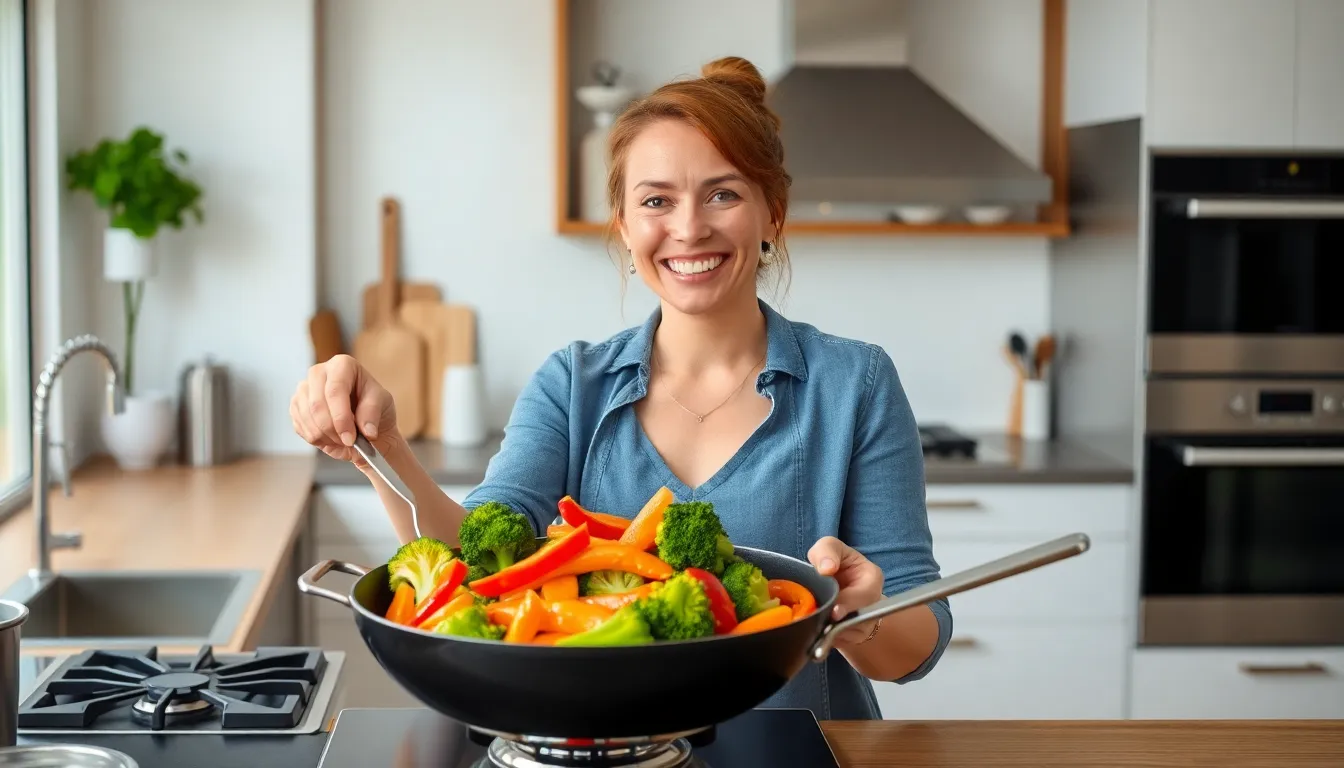In the culinary world, variety isn’t just the spice of life; it’s the secret ingredient to a mouthwatering meal. Whether you’re a kitchen novice or a seasoned chef, exploring different cooking methods can transform your dishes from bland to grand. Imagine the sizzle of a stir-fry or the comforting aroma of a slow-cooked stew—each technique opens up a world of flavors and textures that’ll have your taste buds dancing.
Different Cooking Methods
Various cooking methods impact flavor, texture, and nutritional value. Grilling utilizes direct heat to create charred exteriors and smoky flavors, perfect for meats and vegetables. In contrast, steaming preserves nutrients by cooking food in water vapor, resulting in tender produce without added fats.
Boiling involves immersing food in boiling water, which can enhance flavors in pasta and rice. Sautéing uses a small amount of oil over high heat; this technique caramelizes natural sugars, adding depth to vegetables and proteins. Baking employs dry heat in an oven, allowing for even cooking and browning, ideal for bread and casseroles.
Roasting enhances flavor through Maillard reactions; it excels with root vegetables and meats, producing a crispy texture. Slow-cooking provides a gentle heat over extended periods, making it suitable for stews and tougher cuts of meat, which become tender and flavorful.
Broiling uses high heat from above, similar to grilling, resulting in quick cooking and a delightful crust on foods like fish and cheese. Frying, whether deep or shallow, cooks food quickly in hot oil, yielding a crispy texture. Sous vide, a modern technique, involves vacuum-sealing food and cooking it at precise temperatures in water baths, ensuring even cooking and retention of moisture.
Each method offers unique benefits and flavors, encouraging exploration in both everyday meals and culinary creations. Comprehending these techniques enables cooks to select the ideal method for their ingredients and desired outcomes.
Dry Heat Cooking Methods

Dry heat cooking methods use direct or indirect heat to cook food, resulting in distinct flavors and textures. These methods enhance the natural taste of ingredients while retaining their nutritional value.
Baking
Baking employs dry heat in an enclosed space, typically an oven, allowing for even cooking. This method is ideal for bread, pastries, and casseroles, as it promotes browning and a pleasing crust. Baking utilizes specific temperatures to achieve desired textures, with different recipes requiring different heat levels. Even muffins and cakes benefit from baking, rising due to the interaction of heat with leavening agents. Foods cooked by baking often exhibit a rich aroma and appealing appearance.
Roasting
Roasting brings out deep flavors in meats and vegetables through the Maillard reaction. High temperatures create caramelization on the surface, resulting in a savory taste. Roasted root vegetables, such as carrots and potatoes, gain sweetness and an appetizing texture. This method benefits cuts of meat by delivering a crisp exterior while keeping the interior juicy. Regularly rotated during cooking, food cooks evenly and achieves optimal flavor.
Grilling
Grilling exposes food directly to an open flame or hot surface, producing distinct charred flavors. This method works efficiently for meats, vegetables, and seafood, enhancing them with a smoky aroma. Quick cooking times maintain moisture, leading to tender outcomes. Grilling creates appealing grill marks while sealing in juices, particularly in steak and chicken. This technique fosters outdoor cooking enjoyment, making it popular among home cooks and chefs alike.
Moist Heat Cooking Methods
Moist heat cooking methods utilize water or steam to transfer heat to food, enhancing flavors while preserving moisture and nutrients. Techniques such as boiling, steaming, and poaching play crucial roles in various cuisines.
Boiling
Boiling involves cooking food by immersing it in bubbling water or broth. This method works well for pasta and vegetables, infusing them with flavors while softening their textures. The temperature typically reaches 212°F, effectively breaking down cell walls in food, making it tender. Cooking times vary; for example, spaghetti usually takes 8 to 12 minutes, while vegetables may cook in only a few minutes. Boiling can leach some nutrients but remains a popular choice for quick meals.
Steaming
Steaming uses water vapor to cook food, allowing it to retain more nutrients compared to boiling. It creates a gentle cooking environment, ideal for vegetables and delicate proteins like fish. Steaming requires the food to be placed over boiling water, typically in a steamer basket or a specialized appliance. Cooking times depend on the food type; for instance, broccoli takes about 5 to 7 minutes, while fish may require 10 to 12 minutes. This method preserves the vibrant colors and flavors of the ingredients, making it a preferred choice for healthy meals.
Poaching
Poaching gently cooks food in simmering water or broth, typically at temperatures between 160°F and 180°F. This method suits delicate items like eggs, chicken, and fish, preventing them from drying out. Poaching infuses flavors and enhances textures without adding fat or calories. For example, poached eggs often take about 3 to 5 minutes. Broths or aromatics can enrich the cooking liquid, providing additional flavor. Poaching remains a versatile and health-conscious option for preparing flavorful dishes.
Combination Cooking Methods
Combination cooking methods blend techniques to maximize flavor and texture. These methods often enhance the culinary experience by utilizing both dry and moist heat.
Braising
Braising combines both wet and dry heat, making it ideal for tougher cuts of meat. It begins by searing the meat in hot fat, which develops complex flavors. After browning, liquids such as broth or wine are added, covering the meat partially. This process allows for slow cooking, often in the oven or on the stovetop, ensuring the meat becomes tender and infused with flavors. Common ingredients like aromatics, herbs, and vegetables enhance the final dish further. Examples of braised dishes include pot roast and coq au vin, showcasing the technique’s versatility and appeal.
Stewing
Stewing also employs moist heat but involves cooking smaller pieces of food. The process starts with sautéing meat and vegetables, allowing flavors to meld. Once browned, a sufficient amount of liquid is added to cover the ingredients. Stewing occurs over low heat for an extended period, promoting tenderness and enriching flavors. This method results in hearty meals, such as beef stew or chicken gumbo, that are perfect for colder seasons. The gradual cooking ensures the dish is packed with depth and satisfying textures, making it a favorite among many households.
Modern Cooking Techniques
Modern cooking techniques elevate culinary experiences through precise methods and advanced technology. Two prominent approaches, sous vide and microwave cooking, demonstrate unique benefits in today’s kitchens.
Sous Vide
Sous vide offers precise temperature control for cooking food in vacuum-sealed bags. The method ensures proteins cook evenly, retaining moisture and flavor. Heaters maintain consistent water temperatures, creating results unattainable through traditional methods. Chefs often use sous vide for meat, achieving tenderness and juiciness. Vegetables also benefit from this technique, preserving nutrients while achieving perfect textures. Cooking times can range from an hour to several hours, depending on the desired outcome.
Microwave Cooking
Microwave cooking provides speed and convenience in meal preparation. This method uses electromagnetic radiation to heat water molecules in food, rapidly cooking it. Microwaving retains nutrients better than boiling or frying, making it a healthier option for many dishes. It’s effective for reheating leftovers and can even steam vegetables in minutes. In addition, microwave cooking simplifies meal prep variations, from baked potatoes to scrambled eggs. Cooking times often range from seconds to minutes, demonstrating its efficiency in today’s fast-paced world.
Conclusion
Exploring diverse cooking methods opens up a world of culinary possibilities. Each technique brings its own unique flavors and textures to the table. Whether it’s the smoky allure of grilling or the gentle touch of poaching, there’s a method suited for every dish.
By experimenting with these various techniques, cooks can elevate their meals and create memorable dining experiences. Embracing both traditional and modern methods not only enhances flavor but also encourages creativity in the kitchen. Ultimately, the journey of discovering new cooking techniques can lead to delightful and satisfying meals that everyone can enjoy.

